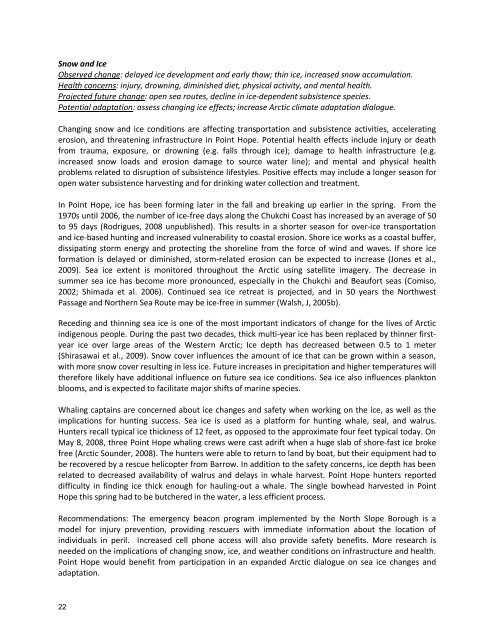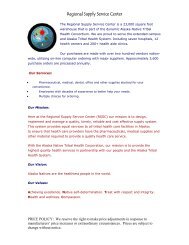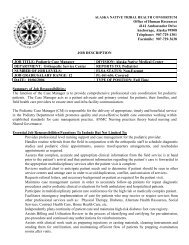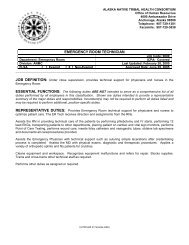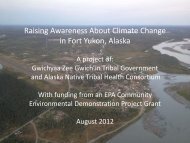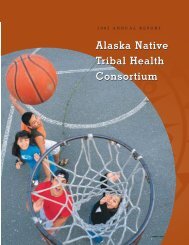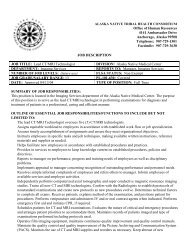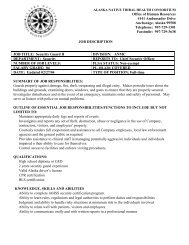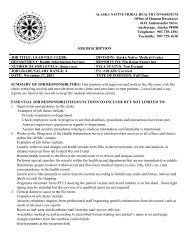Draft Final Climate Change and Health Impacts Point ... - ANTHC
Draft Final Climate Change and Health Impacts Point ... - ANTHC
Draft Final Climate Change and Health Impacts Point ... - ANTHC
Create successful ePaper yourself
Turn your PDF publications into a flip-book with our unique Google optimized e-Paper software.
Snow <strong>and</strong> Ice<br />
Observed change: delayed ice development <strong>and</strong> early thaw; thin ice, increased snow accumulation.<br />
<strong>Health</strong> concerns: injury, drowning, diminished diet, physical activity, <strong>and</strong> mental health.<br />
Projected future change: open sea routes, decline in ice‐dependent subsistence species.<br />
Potential adaptation: assess changing ice effects; increase Arctic climate adaptation dialogue.<br />
Changing snow <strong>and</strong> ice conditions are affecting transportation <strong>and</strong> subsistence activities, accelerating<br />
erosion, <strong>and</strong> threatening infrastructure in <strong>Point</strong> Hope. Potential health effects include injury or death<br />
from trauma, exposure, or drowning (e.g. falls through ice); damage to health infrastructure (e.g.<br />
increased snow loads <strong>and</strong> erosion damage to source water line); <strong>and</strong> mental <strong>and</strong> physical health<br />
problems related to disruption of subsistence lifestyles. Positive effects may include a longer season for<br />
open water subsistence harvesting <strong>and</strong> for drinking water collection <strong>and</strong> treatment.<br />
In <strong>Point</strong> Hope, ice has been forming later in the fall <strong>and</strong> breaking up earlier in the spring. From the<br />
1970s until 2006, the number of ice‐free days along the Chukchi Coast has increased by an average of 50<br />
to 95 days (Rodrigues, 2008 unpublished). This results in a shorter season for over‐ice transportation<br />
<strong>and</strong> ice‐based hunting <strong>and</strong> increased vulnerability to coastal erosion. Shore ice works as a coastal buffer,<br />
dissipating storm energy <strong>and</strong> protecting the shoreline from the force of wind <strong>and</strong> waves. If shore ice<br />
formation is delayed or diminished, storm‐related erosion can be expected to increase (Jones et al.,<br />
2009). Sea ice extent is monitored throughout the Arctic using satellite imagery. The decrease in<br />
summer sea ice has become more pronounced, especially in the Chukchi <strong>and</strong> Beaufort seas (Comiso,<br />
2002; Shimada et al. 2006). Continued sea ice retreat is projected, <strong>and</strong> in 50 years the Northwest<br />
Passage <strong>and</strong> Northern Sea Route may be ice‐free in summer (Walsh, J, 2005b).<br />
Receding <strong>and</strong> thinning sea ice is one of the most important indicators of change for the lives of Arctic<br />
indigenous people. During the past two decades, thick multi‐year ice has been replaced by thinner firstyear<br />
ice over large areas of the Western Arctic; Ice depth has decreased between 0.5 to 1 meter<br />
(Shirasawai et al., 2009). Snow cover influences the amount of ice that can be grown within a season,<br />
with more snow cover resulting in less ice. Future increases in precipitation <strong>and</strong> higher temperatures will<br />
therefore likely have additional influence on future sea ice conditions. Sea ice also influences plankton<br />
blooms, <strong>and</strong> is expected to facilitate major shifts of marine species.<br />
Whaling captains are concerned about ice changes <strong>and</strong> safety when working on the ice, as well as the<br />
implications for hunting success. Sea ice is used as a platform for hunting whale, seal, <strong>and</strong> walrus.<br />
Hunters recall typical ice thickness of 12 feet, as opposed to the approximate four feet typical today. On<br />
May 8, 2008, three <strong>Point</strong> Hope whaling crews were cast adrift when a huge slab of shore‐fast ice broke<br />
free (Arctic Sounder, 2008). The hunters were able to return to l<strong>and</strong> by boat, but their equipment had to<br />
be recovered by a rescue helicopter from Barrow. In addition to the safety concerns, ice depth has been<br />
related to decreased availability of walrus <strong>and</strong> delays in whale harvest. <strong>Point</strong> Hope hunters reported<br />
difficulty in finding ice thick enough for hauling‐out a whale. The single bowhead harvested in <strong>Point</strong><br />
Hope this spring had to be butchered in the water, a less efficient process.<br />
Recommendations: The emergency beacon program implemented by the North Slope Borough is a<br />
model for injury prevention, providing rescuers with immediate information about the location of<br />
individuals in peril. Increased cell phone access will also provide safety benefits. More research is<br />
needed on the implications of changing snow, ice, <strong>and</strong> weather conditions on infrastructure <strong>and</strong> health.<br />
<strong>Point</strong> Hope would benefit from participation in an exp<strong>and</strong>ed Arctic dialogue on sea ice changes <strong>and</strong><br />
adaptation.<br />
22


